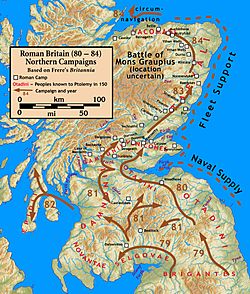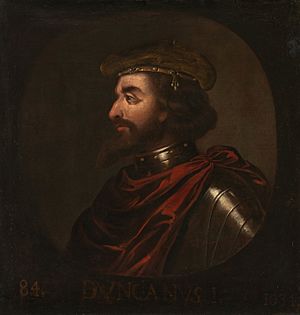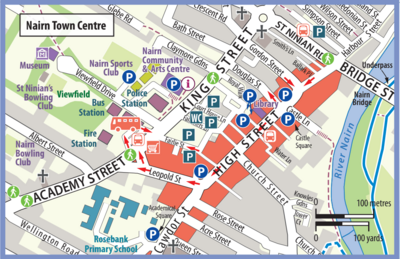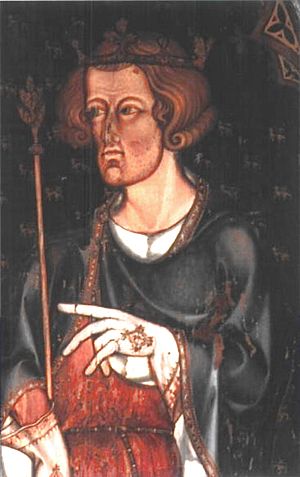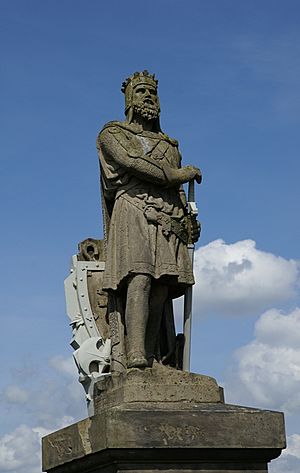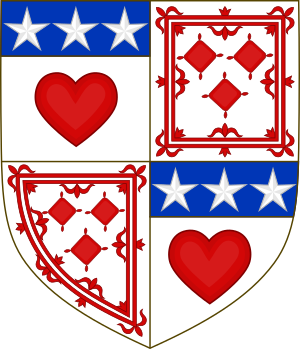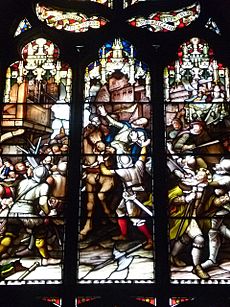History of Nairn facts for kids
Nairn (pronounced NAIRN) is a town and royal town in the Highland area of Scotland. It's an old fishing port and market town located about 17 miles (27 km) east of Inverness. Nairn is also the traditional main town of Nairnshire.
Contents
- Ancient Times: Early People in Nairn
- Early History: From 1 AD to the 1100s
- The 1100s: A Royal Town Emerges
- The 1200s: English Influence and Wars
- The 1300s: Robert the Bruce and More Wars
- The 1400s: Changing Hands and Power Struggles
- The 1500s: New Leaders and Religious Changes
- The 1600s to 1800s: Conflicts and Changes
- The 1800s: Growth and Modernization
- The 1900s: War and New Beginnings
- Images for kids
Ancient Times: Early People in Nairn
Humans have lived in Scotland for about 10,000 years, even before recorded history. It's very likely that people lived in the fertile lands and good fishing spots around Nairn during these ancient times.
Stone Age Life in Nairn
Around 8,000 to 5,000 BC, during the Mesolithic era (Middle Stone Age), people used tools made from flint. Small flint tools have been found in the Culbin Sands area, showing that communities lived nearby.
Later, in the Neolithic period (New Stone Age), from 4,000 BC to 2,500 BC, people learned to build boats for sea travel. The mouth of the Nairn River would have been a perfect spot for travel and shelter. Nearby forests provided food like wolf, wild boar, and deer, as well as materials for tools and clothes.
Bronze Age Discoveries
Many old tools from the Stone Age and Bronze Age have been found south of Nairn, in an area called "The Flint Pit." These include stone axes, flint arrowheads, saws, and scrapers. These finds suggest that hunters lived here and prepared animals. Also, two large circular stone huts, believed to be from the Bronze Age, were found among many others. Since these sites are close to Nairn, it's thought that Nairn itself might have had similar ancient settlements that were later built over. Many of these discoveries are kept at the Nairn Museum.
Early History: From 1 AD to the 1100s
The Picts and Roman Visits
The Picts, an ancient people of Scotland, left behind stone circles in Nairnshire. These circles were often linked to local beliefs and rituals. For example, a stone in Moyness was used to decide if someone was guilty of a crime. If the stone moved when they were on it, they were guilty!
Around 86 AD, a Roman fleet explored the coast of Scotland. A river called Loxa on an old map might be the Nairn River or Lossiemouth. Roman coins and a temporary Roman camp have been found near Nairn, suggesting some Roman presence, even if it was just for a short time.
Nairn's Beginnings and Early Castles
The exact start of Nairn town is a bit of a mystery. Some believe that Sigurd, Earl of Orkney, built a fort called Ekkailsbakki here in the late 800s. This was when the mouth of the Findhorn River was near what is now the Old Bar area of Nairn. Sigurd took control of the Moray area, which included Nairn.
There's also proof of a castle in Nairn in the 1000s. It was attacked by Danes along with castles in Forres and Elgin.
Christianity Comes to Nairn
The seal of Nairn shows a connection to St. Ninian, an early Christian figure. However, it's not clear if he visited Nairn. The first clear account of Christianity in Nairn comes from St. Columba. In 563, he traveled to Scotland and visited the pagan King Bridei in 565, who ruled the Nairn area from his fort in Inverness. St. Columba preached Christianity throughout the Highlands, including Nairn. A chapel found in the Lochloy area of Nairn is thought to be from this time.
Kings of Alba and the Barons of Cawdor
Nairn was likely controlled by the Mormaer of Moray (an early Scottish ruler). This included Macbeth, who became king in 1040. After Macbeth, Malcolm III of Scotland became king in 1058. Around this time, the first Baron of Cawdor, Hugh de Cadella, was given land and power, including parts of modern Nairn. The Barons, and later Thanes, of Cawdor would play a big role in Nairn's history.
The 1100s: A Royal Town Emerges
The Barons of Cawdor's Influence
In 1104, King Edgar gave the lands of Cawdor to Gilbertus de Cadella, the second Baron of Cawdor. This title, which included control over Nairn, later passed to Alexander de Cadella.
Nairn was traditionally part of the diocese of Moray, which was formed around 1122. This suggests that much of the land where Nairn and its castle would be built might have belonged to the church.
Nairn Becomes a Royal Burgh
David I of Scotland took control of Moray, including Nairn and Inverness, around 1130. He encouraged towns to grow and become centers for trade. Inverness became a shipbuilding hub, while towns like Nairn, Forres, and Elgin became important fishing ports, especially for herring.
Nairn became a Royal Burgh (a town with special trading rights granted by the king) during the time of David I. Later kings, like William the Lion and Alexander II, confirmed these rights, even though the original documents from David I are now lost.
Rebellions and Language Changes
Wymund, also known as Malcolm MacHeth, tried to start a rebellion against David I with men from Inverness, Forres, Elgin, and Nairn. This rebellion failed, and MacHeths was captured.
Later, in 1153, Malcolm IV became king. To reduce unrest in the Moray area, he moved some Nairn residents to other parts of his kingdom. He also brought in English-speaking knights and merchants. This, along with English-speaking churches, helped English become the main language in Nairn, replacing Scottish Gaelic.
William the Lion and Nairn Castle
In 1165, William the Lion took control of Nairn. He often visited Nairn Castle, which stood near the High Street. Today, you can still find Castle Lane and Castle Square in Nairn, marking the old castle's location. The castle was protected by the River Nairn on one side and by ditches and walls on the other. William the Lion appointed the first governor and sheriff of Nairn and its castle, William Pratt, and a local official named Andrew Cumming.
A document from William the Lion's time shows that the Bishop of Nairn gave land to the King for expanding Nairn Castle. This suggests that the church might have owned much of Nairn's land and the castle itself before the King took it over.
The 1200s: English Influence and Wars
Sheriffs and Castle Repairs
After William the Lion, his son Alexander II ruled Nairn from 1214. Later, Alexander III ruled from 1249. During their reigns, the sheriffs of Nairn were in charge of Nairn Castle. In 1264, the sheriff, Alexander de Moravia, was paid by the king for repairs to the castle, like plastering the hall and adding locks. This shows the king's control over the castle, even though the sheriff managed its daily upkeep.
Edward I and Scotland's Crown
After Alexander III died, his granddaughter Margaret was supposed to become queen, but she died on her way from Norway. This led to a big argument over who should be the next King of Scotland.
Agents of Edward I stopped in Nairn in 1290 while trying to arrange Margaret's marriage to Edward's son. Rival groups of nobles formed in Scotland. People from Moray (including Nairn) asked Edward I for help, saying that other nobles were causing trouble, burning towns, and harming people in Nairn. This gave Edward I a reason to get involved.
Edward I became the "Lord Paramount" (supreme ruler) of Scotland in 1292. He took control of all royal forts, including Nairn Castle, which then had English soldiers. William de Braytoft, an English knight, managed the castle daily. Edward I later named John Balliol King of Scots, and the English flag was raised over Nairn Castle.
The First War of Scottish Independence
Scotland formed an alliance with France in 1295 and attacked England. Edward I brought a large army to Scotland. Nairn Castle was given up to him in June 1296. Edward I then ordered all important Scottish landowners and churchmen to meet him in nearby Elgin to swear loyalty.
Sir Andrew Moray raised an army in 1297 to fight against Edward I's control of Scotland. He asked the people of Nairn to join him. Royal castles like Forres, Elgin, and Nairn were attacked. By late summer, Edward I had lost control of Nairn and most castles north of the River Forth.
Sir Andrew Moray and his army, which included men from Nairn, joined William Wallace and defeated the English army at the Battle of Stirling Bridge. Sadly, Moray was injured and died later that year.
The 1300s: Robert the Bruce and More Wars
Robert the Bruce Rises
In 1303, Edward I brought his army back to Scotland, burning and destroying many places. Nairn Castle was again taken by English troops. However, later that year, Sir Climes of Ross raided Nairn Castle, killing its governor.
By 1304, most Scottish leaders had surrendered to Edward I, except for William Wallace. Wallace is believed to have passed through Nairn on his way north. In 1305, Robert the Bruce, a former leader of Scotland, was accused of treason by Edward I. He returned to Scotland and was crowned Robert I, King of Scots, in 1306, becoming the new ruler of Nairn.
The office of sheriff and constable of Nairn Castle became a family right for the family of Cawdor. King Robert I also gave the lands and town of Nairn to his brother-in-law, Hugh, Earl of Ross.
King Robert I's Rule and Conflicts
Edward I's army returned in 1306, defeating Robert the Bruce. During this time, Nairn was likely under English rule. In February 1307, Robert the Bruce gathered his forces and burned Nairn Castle. Edward I died shortly after. Robert the Bruce continued to win victories, taking castles near Nairn.
In 1308, a key moment happened near Nairn. William II, Earl of Ross, who had fought for Edward I, met Robert the Bruce to surrender. Robert accepted his surrender, and they fought together in future battles, including the 1314 Battle of Bannockburn.
In 1310, King Robert I wrote a special document in Nairn, naming William, Thane of Cawdor, as the Sheriff of Nairn. This document is still kept at Cawdor Castle. In 1312, Robert I created the title of Earl of Moray for his nephew Earl Thomas Randolph, which included Nairn, Forres, and Elgin. This caused some confusion about who truly controlled Nairn, as Hugh, Earl of Ross, still had overall power.
Scotland continued to fight England until 1328, when the Treaty of Edinburgh–Northampton was signed, recognizing Scotland as an independent kingdom with Robert the Bruce as its king. Robert I ruled until his death in 1329.
King David II and the Second War
King David II became King of Scots at age five in 1329. Earl Thomas Randolph was named Guardian of Scotland (a regent who rules for a young king), giving him great power over Nairn. However, he died just three years later in 1332.
His death led to the Second War of Scottish Independence. Edward Balliol, supported by Edward III of England, invaded Scotland. Sir Andrew Moray, who had fought with William Wallace, traveled through Nairn, gathering an army to support the young King David II. As Regent, he often used Nairn as a base.
Edward III's army destroyed Nairn, burning towns, Inverness, and food stores. English troops were left in places like Nairn Castle, but Sir Andrew Moray soon overthrew them. Scotland, including Nairn, faced famine, but Nairn's herring fishing helped a lot.
Many people from Nairn were killed in the Battle of Halidon Hill in 1333. The Earl of Moray was captured in 1335, and Nairn's governance went back to the crown. By 1342, England had lost all control in Scotland. The war ended in 1357 with the Treaty of Berwick.
King David II returned to Scotland in 1363. Nairn suffered greatly from the wars and food shortages. David II died in 1371.
The Wolf of Badenoch
In 1371, King Robert II took away the lands and power of William III, Earl of Ross, who had controlled Nairn. The Sheriff of Nairn and Constable of Nairn Castle titles passed to Alexander Stewart, Earl of Buchan, known as 'The Wolf of Badenoch'. He ruled with his own private forces, causing problems for other landowners and the church.
Many complaints reached the king about The Wolf of Badenoch. In 1388, his titles were removed. He later sought revenge after his father's death in 1390. He destroyed parts of Nairn and Forres, especially church lands, and burned down Elgin Cathedral. The Wolf of Badenoch died in 1405.
The 1400s: Changing Hands and Power Struggles
King James I and Invasions
The Sheriff of Nairn title continued in the Calder family. James I of Scotland became king in 1406. Nairn was invaded in 1411 by Donald of Islay, Lord of the Isles, who claimed the lands of Ross and Inverness. He forced men from Nairn to join his army. After battles, the titles of Earl of Ross were returned to Euphemia II, Countess of Ross, who then gave them to the Duke of Albany, who passed them to his son John Stewart, Earl of Buchan, including the Shire and Castle of Nairn.
Despite these invasions, the Cawdor estate, supported by Nairn, was wealthy and expanded its lands.
King James I returned from English captivity in 1424. He traveled north to Inverness, where he arrested many Highland leaders, including Alexander of Islay, who had claims to Nairn. James I died in 1437.
King James II and the Thane of Cawdor
Under James II of Scotland, Alexander of Islay took the title Earl of Ross, which included the sheriffdom of Nairn. William Fleming was named Burgess of Nairn, likely handling the town's daily affairs.
A powerful group of nobles, including the Earl of Ross, formed a pact against the king. The Earl of Ross took royal castles, including Inverness. The King killed one of the pact members, William Douglas.
In 1454, William, 6th Thane of Cawdor, was told to fortify Cawdor Castle. He was given financial control over the lands and income of the Earldom of Moray, including the sheriffdoms of Elgin, Forres, Nairn, and Inverness. By 1458, the Thane of Cawdor controlled vast lands in northern Scotland.
King James III and Permanent Control
James III of Scotland began his reign in 1460. The Sheriffdom of Nairn was held by William Calder, 6th Thane of Cawdor. In 1477, the Earl of Ross lost his control over the Earldom of Ross and the sheriff offices of Inverness and Nairn. This was the last time the Earldom of Ross had overall power over Nairn's sheriffdom.
In 1476, William Calder, 7th Thane of Cawdor, received a special document from the King, making all his lands into one "thanage" (a type of estate) of Cawdor. He also received the permanent right to be the hereditary Sheriff and Keeper of the King's castle at Nairn.
Calder vs. Campbell: A Family Feud
In 1492, the Church and the Bishop of Moray held a lot of land and power in Nairn. When a dispute over land boundaries arose, it was settled in Nairn Parish Church.
King James VI visited Inverness in 1492 with charges against William Calder, 7th Thane of Cawdor, for killing four men. He was pardoned and passed his title to his son, John Calder, in 1493. William was again accused in 1494 but pardoned by King James II. John died shortly after.
The title then passed to Muriel Calder of Cawdor in 1502, who was a child. To protect her from her uncles, she was taken to Kilravock Castle. However, Archibald Campbell, 2nd Earl of Argyll, forced her guardian to hand her over. King James IV then named Archibald Campbell and Hugh Rose of Kilravock as Muriel's guardians.
The 1500s: New Leaders and Religious Changes
The Campbell Family Takes Over
The lands of Cawdor and the Sheriffdom of Nairn were briefly held by other members of the Calder family. In 1510, Hugh Calder became Sheriff of Nairn and Constable of the King's Castle.
Archibald Campbell, 2nd Earl of Argyll, became the King's Crowner in Nairn, giving him power equal to the Sheriff. This allowed him to protect Muriel's interests. Muriel returned to her family estate in 1502 and married Sir John Campbell in 1510.
King James V's Reign
Sir John Campbell and Lady Muriel moved to Cawdor Castle in 1524. Sir John bought more lands and the Sheriffdom of Nairn from Hugh Calder in 1528. He also acquired extensive lands in other areas. A Royal Charter later made Lady Muriel, 9th Thane (Thaness) of Cawdor, the formal ruler of a large estate.
King James V focused on increasing royal income and taxing churches. He was often away on trips, but his policies affected Nairn's church. James Stewart was granted the title Earl of Moray, including Nairn, in 1531. King James V supported Catholicism, while England under Henry VIII supported the Scottish Reformation, leading to war. James V died in 1542.
Mary, Queen of Scots and the Reformation
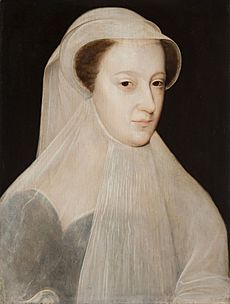
Mary, Queen of Scots, daughter of King James V, ruled Scotland from 1542. Her half-brother, James Stewart, who would become the Earl of Moray, became a strong supporter of the Scottish Reformation (a movement to change the church). This caused dissatisfaction in Nairn's churches.
In 1562, Mary traveled north to Inverness, passing through Nairn. She visited local gentry and religious figures. The Provost (a chief magistrate) of Nairn, John Rose, welcomed her on Nairn High Street. The castle was still a strong building then. Mary continued to Inverness without staying overnight in Nairn.
Mary was denied entry to Inverness Castle by George Gordon, 4th Earl of Huntly, a powerful lord who was out of favor with the queen. Many local nobles from Nairn and the surrounding area welcomed the queen, and the castle was quickly surrendered. James Stewart was named the 1st Earl of Moray. Lord Huntly's defeat helped the Reformation progress in Scotland.
Mary later married Henry Stuart, Lord Darnley, a Catholic, in 1565. The Earl of Moray opposed this marriage and rebelled, but the rebellion was short-lived. Lord Darnley was killed in 1567, and Mary married the man believed to have murdered him. This caused unrest among both Protestants and Catholics.
The Earl of Moray as Regent
Mary was forced to give up her crown in 1567 to her one-year-old son, James. James Stewart, the 1st Earl of Moray, was named Regent of Scotland, giving him significant control. He sold some of Mary's jewels to fund the Reformation.
With the Earl of Moray as Regent, the Reformation continued in Scotland. Nairn's churches adapted, with the first Protestant minister, Mr. John Young, arriving in 1568.
In 1568, Queen Mary escaped and rallied allies, but Moray defeated her forces at the Battle of Langside. Mary fled to England. James Stewart continued military operations against her supporters. He was assassinated in January 1570, becoming the first head of state to be killed by a firearm. The title of Earl of Moray passed to his daughter, Elizabeth Stuart, 2nd Countess of Moray.
King James VI and Witch Trials
Lady Muriel, 9th Thane of Cawdor and Sheriff of Nairn, lived until 1575. The Thanedom then passed to her grandson, John Campbell, who had little interest in Cawdor and spent his time elsewhere. Cawdor Castle became neglected. John sold parts of his estate to fund his lifestyle.
King James VI became an adult ruler in 1579. He visited Nairn in 1589 and famously said that the High Street was so long that people at either end spoke different languages: Scottish Gaelic and Scots.
King James VI was very concerned about witches and supported the North Berwick witch trials. This royal support led to many witch trials across Scotland, including in Nairn, where many people were killed.
In 1591, John Campbell, 10th Thane of Cawdor and Sheriff of Nairn, was killed. In the same year, the Countess of Moray died, and the title passed to James Stewart, 2nd Earl of Moray.
The 1600s to 1800s: Conflicts and Changes
Family Feuds in Nairn
After several changes, the Thanedom of Cawdor and Sheriff of Nairn title came to Sir Colin "Tutor of Cawdor" Campbell, who restored Cawdor Castle. His son, Sir Hugh Campbell, became 15th Thane of Cawdor in 1642.
The early 1600s in Nairn saw conflicts between powerful families, especially the Roses of Belivat and the Sheriff of Nairn. The Falconer family accused the Roses of stealing cattle and attacking their tenants. The Roses were declared rebels but continued their attacks.
The Roses used their numbers to fight against officers and attack families they felt had wronged them. Other families, like the Dunbars and Falconers, also raised supporters. The Dunbars burned property linked to the Roses. A local historian described the Roses of Belivat as "bold, daring, and headstrong people, who put up with no injuries or affronts."
Market-day in Nairn almost became a bloody battle as both sides gathered. The Baron of Kilravock and Laird of Mackintosh helped settle the dispute. Over the years, allies from far away joined both sides. The murder of a Dunbar by the Roses brought the government's attention, and an order was issued to stop the rebellious Roses.
The Baron of Kilravock was told to arrest members of his own Rose family but said they were too many to control. He was imprisoned for not doing his duty but was freed by King James in 1603. The Roses continued to raid Nairn, focusing on the Dunbars. The Sheriff of Nairn, a Dunbar, burned down the Roses' historic home. Several Clan Rose members were executed or imprisoned. Eventually, the remaining Roses made peace with Clan Dunbar, bringing an end to this violent period in Nairn's history.
Wars and Royal Visits
From 1644 to 1645, James Graham, 1st Marquess of Montrose led the Royalists in the Wars of the Three Kingdoms. On May 9, 1645, the battle of Auldearn was fought two miles southeast of Nairn. The Royalists won this battle. Montrose's men burned and looted the Laird of Cawdor's house and lands in Nairn, as well as nearby Elgin, because they believed they supported the other side.
During the Jacobite rising of 1715, people in Nairn were forced to provide arms, horses, or food. While some local gentry joined the Jacobite cause, most of the district remained loyal to the Hanoverian (British royal) cause.
In 1746, Duke of Cumberland and his army approached Nairn. They entered the town, and some troops stayed in buildings, while the main army camped outside. The Duke of Cumberland stayed in Nairn the night before the famous battle of Culloden on April 15, 1746.
After the Battle of Auldearn, Montrose's men burned Cawdor's house in town. In 1747, the old system of hereditary titles was abolished, meaning the offices of sheriff and constable of the castle were no longer passed down in the Cawdor family.
In 1773, Samuel Johnson noted that the Gaelic language was still spoken in Nairn, showing its continued cultural importance.
The 1800s: Growth and Modernization
In 1820, a wharf and harbor were built at the mouth of the River Nairn by Thomas Telford, a famous engineer. This cost £5500. By 1882, 91 boats were registered at the harbor, mostly used for herring fishing. Nairn exported timber, corn, potatoes, eggs, smoked haddocks, and stone, and imported food, goods, and coal.
The first local newspaper, the Nairnshire Mirror, was printed from 1845 to 1854. The second, the Nairnshire Telegraph, started in 1853 and continued until 1939.
Nairn was connected to Inverness by rail in 1855. This line was later extended to Forres and then connected to Aberdeen in 1861.
In the 1860s, Nairn became a popular holiday town. Dr. John Grigor, a doctor whose statue is in Viewfield, advised his wealthy clients to holiday there because of its warm climate. After the Nairn railway station opened in 1855, new houses and hotels were built in the elegant West End.
Another newspaper, the Moray and Nairn Express (later The Northern Scot), started in 1880 and is still published weekly.
The 1900s: War and New Beginnings
Nairn's wide sandy beaches were used for training exercises for the Normandy landings during World War II. Landmines were planted on the beaches and cleared in 1945. During this time, two German spies who had arrived by U-boat were arrested at Nairn railway station while trying to board a train to Inverness.
In July 1987, the Nairnshire Telegraph name was used again for a local newspaper publisher, based on Leopold Street in Nairn.
Images for kids


